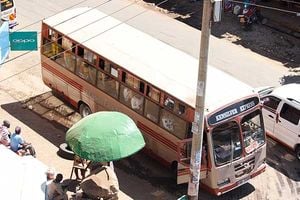Transporting meat in Kenya

A boda boda rider transports meat from an abattoir in Elburgon.
Upon completing slaughter at a government-licensed abattoir, the beef, lamb, chevon, chicken, edible offals and processed meat products are ready to be taken to points of sale.
The meat must be packaged, packed and moved in a manner that protects it from contamination, attack or spoilage.
Meat is moved by road, air or water. In-country meat movement is by road, while exports and imports are by air and water.
Consignments moving by road may be frozen, chilled or fresh.
Fresh meat accounts for the largest percentage of the consignments. It has a shelf-life of several hours and is therefore only moved relatively short distances.
Fresh meat should be transported as quickly as possible to prevent deterioration.
The law gives requirements. Fresh meat is transported in carriers or containers. Meat carriers/containers are licensed annually to ensure they comply with food safety guidelines.
Carriers are specialised refrigerated vehicles while containers are detachable box compartments. Meat containers are mostly metallic and are moved on motorbikes or vehicles.
Containers and carriers for road transport should be exteriorly painted white with a chevron-red band across the middle. The word “Meat” should be several inches above the band.
Sea consignments mainly consist of frozen meat with a shelf-life of a year. Such is packed in refrigerated shipping containers.
Consignments moving by air consist mostly of chilled meat with a shelf-life of two weeks. The meat is packed in special air freight containers.
Meat may be transferred between the various modes of transportation during shipment. It may also be held at warehouses or air and seaports.
The other critical public-health safeguard is the ability to determine the origin of the meat.
The trace back procedures are two-pronged; use of markings (official stamps) on the meat, or documentation. All meat produced at an abattoir must be stamped. Stamping involves affixing of special marks onto the carcass using food-grade ink. The stamp contains information on the abattoir.
On the aid of documentation for traceability, there is the use of product labels and certificates.
Product labelling entails placing package labels on the meat and meat products. Labels contain details on the abattoir, production date, expiry date, storage conditions and batch details.
A certificate of transport is a control document issued at an abattoir indicating the source and destination of the meat.
Meat export and import certificates are additional official documents for the transport of meat out and into Kenya respectively.
Individuals and entities involved in transporting meat are directly responsible for ensuring it remains fit for consumption.
Dr Agnes Maina is the Directorate of Veterinary Services, Kenya, head.




